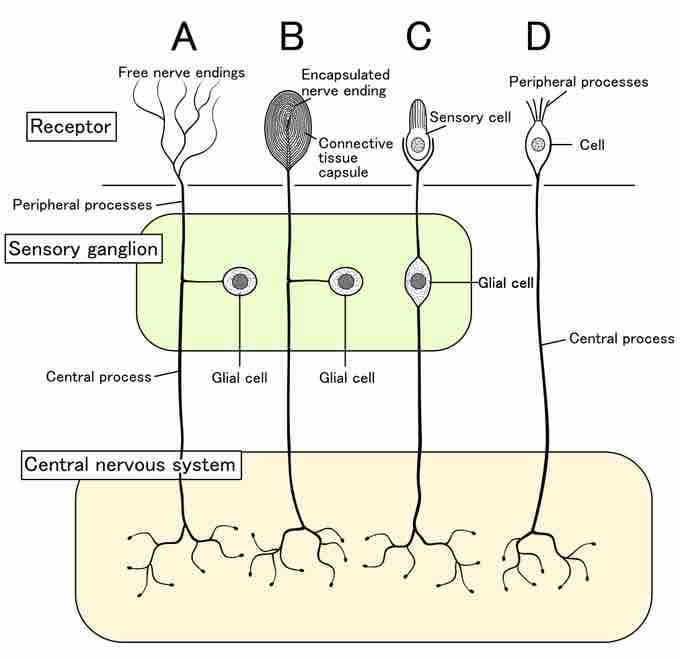Integration of Signals from Mechanoreceptors
The configuration of the different types of receptors working in concert in the human skin results in a very refined sense of touch . The nociceptive receptors (those that detect pain) are located near the surface. Small, finely-calibrated mechanoreceptors (Merkel's disks and Meissner's corpuscles) are located in the upper layers and can precisely localize even gentle touch. The large mechanoreceptors (Pacinian corpuscles and Ruffini endings) are located in the lower layers and respond to deeper touch. Consider that the deep pressure that reaches those deeper receptors would not need to be finely localized. Both the upper and lower layers of the skin hold rapidly- and slowly-adapting receptors. Both primary somatosensory cortex and secondary cortical areas are responsible for processing the complex picture of stimuli transmitted from the interplay of mechanoreceptors.

Sensory receptor structure
Structure of four different types of sensory receptors found within the sensory system.
Density of Mechanoreceptors
In the somatosensory system, receptive fields are regions of the skin or of internal organs. During the transmission of sensory information from these fields, the signals must be conveyed to the nervous system. The mechanoreceptors are activated, the signal is conveyed, and then processed. Some types of mechanoreceptors have large receptive fields, while others have smaller ones. Large receptive fields allow the cell to detect changes over a wider area, but lead to a less-precise perception. Touch receptors are denser in glabrous skin (the type found on human fingertips and lips, for example), which is typically more sensitive and is thicker than hairy skin (4 to 5 mm versus 2 to 3 mm). Thus, the fingers, which require the ability to detect fine detail, have many, densely-packed (up to 500 per cubic cm) mechanoreceptors with small receptive fields (around 10 square mm), while the back and legs, for example, have fewer receptors with large receptive fields. Receptors with large receptive fields usually have a "hot spot": an area within the receptive field (usually in the center, directly over the receptor) where stimulation produces the most intense response. Tactile-sense-related cortical neurons have receptive fields on the skin that can be modified by experience or by injury to sensory nerves, resulting in changes in the field's size and position. In general, these neurons have relatively large receptive fields (much larger than those of dorsal root ganglion cells). However, the neurons are able to discriminate fine detail due to patterns of excitation and inhibition relative to the field, which leads to spatial resolution.
The relative density of pressure receptors in different locations on the body can be demonstrated experimentally using a two-point discrimination test. In this demonstration, two sharp points, such as two thumbtacks, are brought into contact with the subject's skin (though not hard enough to cause pain or break the skin). The subject reports if they feel one point or two points. If the two points are felt as one point, it can be inferred that the two points are both in the receptive field of a single sensory receptor. If two points are felt as two separate points, each is in the receptive field of two separate sensory receptors. The points could then be moved closer and re-tested until the subject reports feeling only one point. The size of the receptive field of a single receptor could be estimated from that distance.